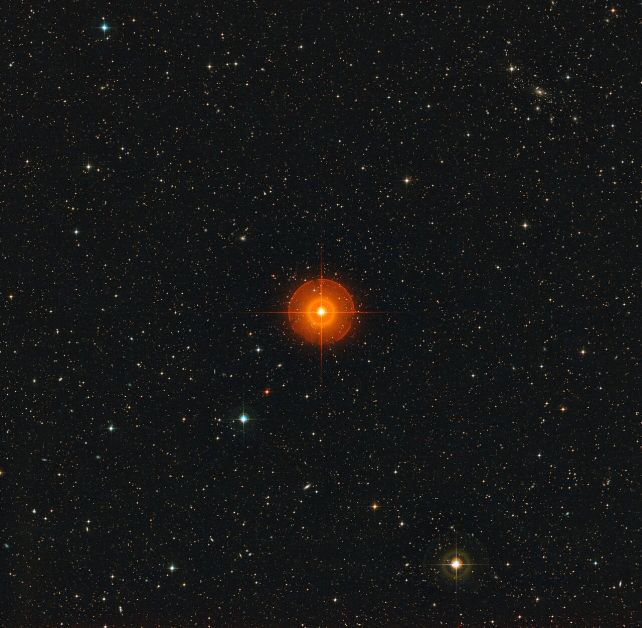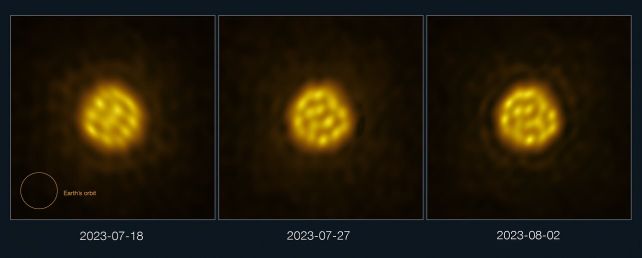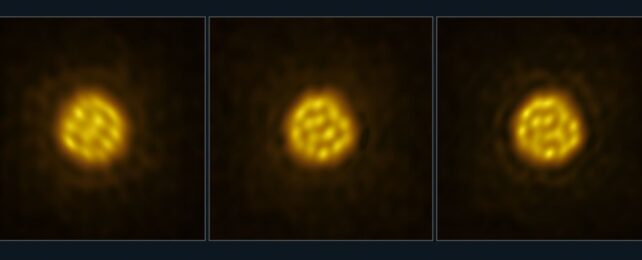On a star 180 light-years away, astronomers have just imaged the surface changes that take place due to the constant cycling of heat within.
The three resulting snapshots represent a fortnight of shifting patterns on the star R Doradus, a red giant star nearly 350 times wider than the Sun, roiling and boiling with convection as it undergoes the last stages of its lifespan.
The new study marks the first time humanity has been able to image this process in a star other than the one at the center of our own Solar System. The changes astronomers mapped on the surface of R Doradus represent enormous bubbles of heated gas, 75 times the size of our own Sun, rising to the surface and subsiding again, on timescales much shorter than astronomers had expected.
"This is the first time the bubbling surface of a real star can be shown in such a way," says astronomer Wouter Vlemmings of Chalmers University of Technology in Sweden. "We had never expected the data to be of such high quality that we could see so many details of the convection on the stellar surface."
R Doradus is the perfect object to study if we want to understand surface level changes on stars other than the Sun. It's very large, which means there's more surface area. The star's activity is bigger, too. To see a significant level of detail at even this relatively short interstellar distance, a larger size with bigger actions is going to be easier to image.

We know stars have convection processes as heat generated in the core bubbles outwards towards the surface. On the Sun, we see this in convection granules that tend to be around 1,000 kilometers (620 miles) across, a little bit smaller than the state of Texas. They boil up from the center, and fall away around the edges, persisting for around 20 minutes before dissipating.
Deeper down, granulation occurs on larger scales. Mesogranules are granules that are between around 5,000 and 10,000 kilometers across, with a lifespan of about three hours. And supergranules measure around 32,000 kilometers across, and hang around for around 20 hours.
Using the powerful Atacama Large Millimeter/submillimeter Array telescope in Chile, Vlemmings and his colleagues hoped to discern details of this process in another star, far from the Solar System. And their results were astonishing.

"Convection creates the beautiful granular structure seen on the surface of our Sun, but it is hard to see on other stars," says astronomer Theo Khouri of Chalmers University of Technology.
"With ALMA, we have now been able to not only directly see convective granules – with a size 75 times the size of our Sun! – but also measure how fast they move for the first time."
The convection granules are huge, and the researchers were not entirely sure why. The granules on R Doradus could be the red giant equivalent to mesogranules or supergranules, or a different kind of granulation specific to red giant stars. They could also be different kinds of granule superimposed to deliver a pronounced effect.
What we can't do, at this point, is directly correspond the granules on R Doradus to any known behavior of the Sun. We know they involve convection, but what makes the granules so enormous is unknown at this time.
In addition, the granules seen on R Doradus seem to have a cycle of around a month, which was a lot faster than expected, given what we have observed on the Sun.
But red giant stars are very different from the Sun, which is comfortably in the middle of its lifespan. Red giant stars are those that have run out of hydrogen in their center and are powered by shell burning, which is the fusion of hydrogen in a shell around the core. This process is what puffs the star up to many times its original size. Astronomers predict that the Sun's red giant phase will see it possibly expand out to the orbit of Mars.
Because there are limitations on what we can observe from such huge distances, there's a lot we don't know about red giants. The very short lifespan of the convection granules compared to solar granules may be just business as usual at this late stage of a star's life.
"We don't yet know what is the reason for the difference. It seems that convection changes as a star gets older in ways that we don't yet understand," Vlemmings says.
The images of R Doradus represent a first, very important step towards understanding these peculiar changes.
The research has been published in Nature.
